
Home
Services
About us
Blog
Contacts
Why Real Estate Developers Need a Custom CRM System
1. Introduction: The CRM Struggle in Real Estate
2. Market Landscape: What Real Estate Professionals Use Today
3. The Real Challenges of Real Estate CRM
4. Benefits of Custom CRM Development for Real Estate Developers
5. How We Build Custom CRM Systems at A-Bots.com
6. Real ROI: Why Custom CRM Pays Off
7. The Future is Custom
1. Introduction: The CRM Struggle in Real Estate
If you ask ten real estate developers about the software they use to manage leads, listings, and deals, chances are you’ll get eleven different answers. One uses spreadsheets. Another swears by Salesforce. A third relies on WhatsApp and a whiteboard. And one guy? He still keeps client notes on Post-its stuck to the dashboard of his truck.
It’s funny — but also painfully true.
The real estate industry is full of dynamic professionals handling multimillion-dollar deals — yet many still operate with chaotic systems that leave leads lost, follow-ups forgotten, and data scattered across inboxes, chats, and outdated software.
According to a 2022 study by Capterra, 65% of real estate companies adopt a CRM within the first five years of launching. But here’s the kicker: nearly half of those end up abandoning their system or using only a fraction of its capabilities. Why? Because most off-the-shelf CRM tools aren’t built for real estate — and especially not for developers.
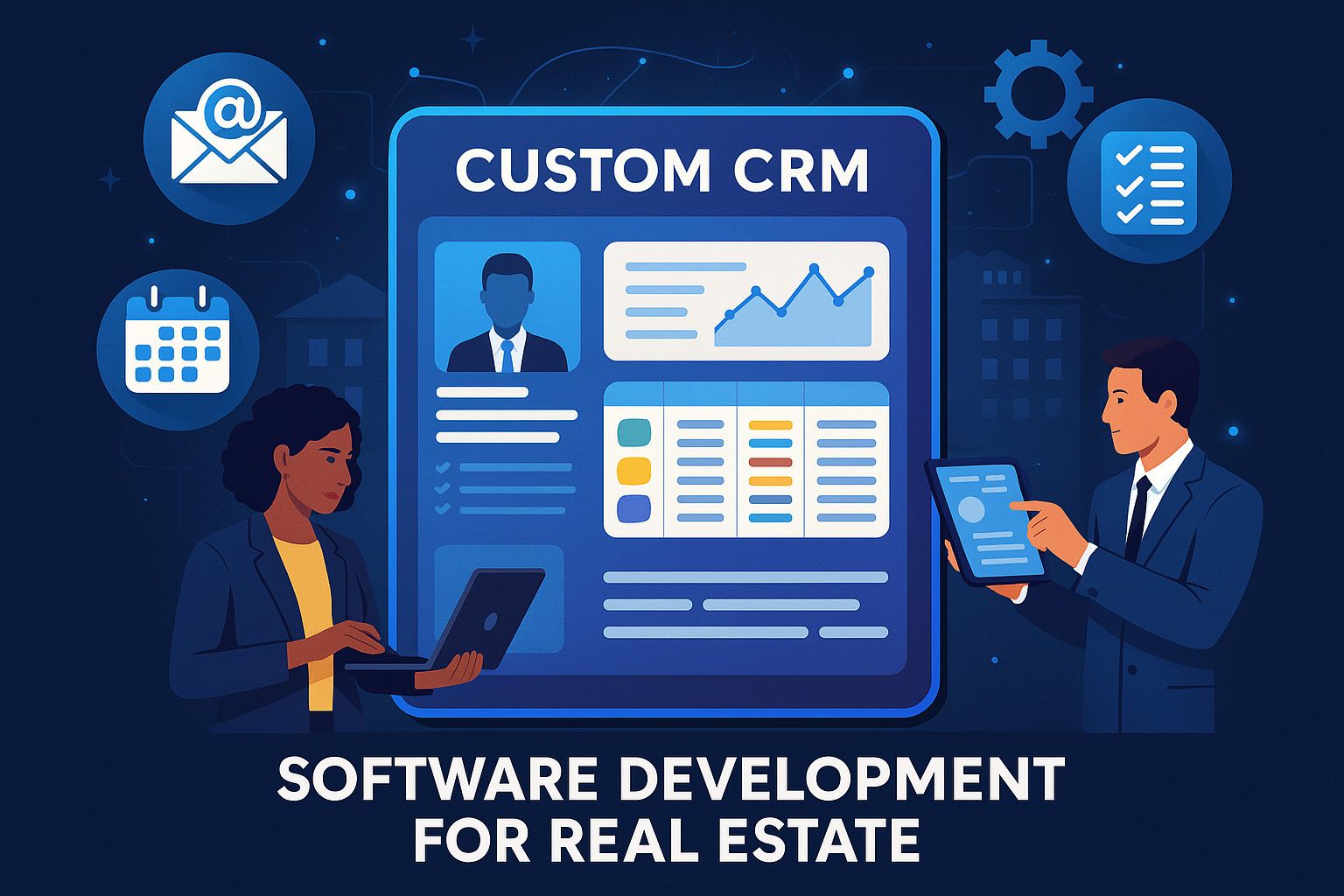
Let’s face it — real estate isn’t just about tracking contacts. It’s about:
- Managing multiple, high-stakes projects at once
- Coordinating with brokers, lawyers, investors, and contractors
- Scheduling viewings, approvals, and closings
- Ensuring regulatory compliance, digital signatures, and financial traceability
- Handling dozens of leads per day from different channels — and following up fast
Trying to do all that with a system built for SaaS startups or call centers just doesn’t work. Generic CRMs tend to be bloated with irrelevant features, difficult to customize, and disconnected from the unique flow of real estate operations.
🔍 One developer in Texas told us he used a CRM that required five clicks just to update a unit’s status. By the time he was done, the unit had already sold.
The stakes are high. A delayed follow-up can cost millions. A missed document can delay closing. An unsecured system can leak sensitive investor data. For real estate developers and firms, the CRM isn’t just a tool — it’s a core operational engine.
Yet despite this, many professionals still struggle with outdated, inflexible systems — or no system at all. Some turn to big-name solutions like HubSpot or Salesforce, only to find they need a full-time administrator to make it work. Others try real estate–focused CRMs like Wise Agent or RealtyJuggler, only to discover they can’t handle complex development workflows.
Meanwhile, the global real estate software market continues to grow — projected to hit $28.63 billion by 2031, with a CAGR of 12.6% (Finance Yahoo, 2024). And CRM is a central part of that ecosystem. But the market’s growth doesn’t mean it’s solving everyone’s problems.
So what’s the alternative? A system that works like your business does — not one that forces you to adapt to it.
In this article, we’ll explore the limitations of mainstream CRMs, why custom CRM development is becoming the preferred choice for serious real estate developers, and how companies like A-Bots.com are helping real estate teams gain clarity, control, and scalability through tailored digital solutions.
Because in this industry, you can’t afford to lose leads — or time — to the wrong software.

2. Market Landscape: What Real Estate Professionals Use Today
The real estate industry has no shortage of CRM options. From massive enterprise platforms like Salesforce and HubSpot to niche players like Wise Agent, Follow Up Boss, and RealtyJuggler, agents and developers alike are presented with an overwhelming menu of choices. And yet — despite the variety — many professionals still feel underserved, overcharged, or overwhelmed.
Let’s take a quick look at what’s currently dominating the market:
- Salesforce
Salesforce is widely used across industries and offers deep customization. However, for most real estate developers, it’s simply too much — too complex, too expensive, and too reliant on third-party consultants for setup.
🔻 Biggest issue: Overengineering. It requires a dedicated admin to maintain and often includes features irrelevant to real estate.
- HubSpot CRM
Loved for its clean interface and free starter tier, HubSpot is often the go-to CRM for small real estate agencies. But when it comes to handling large-scale development projects, property segmentation, or multi-phase deal structures, it hits limits quickly.
🔻 Biggest issue: Lacks real estate–specific workflows and forces users into rigid pipelines.
- Zoho CRM
Known for affordability and wide integration options, Zoho is attractive to mid-sized firms. However, the learning curve can be steep, and many users report needing to “hack” it into shape for real estate-specific needs.
🔻 Biggest issue: General-purpose design with limited vertical features.
- Real Estate–Focused CRMs (Wise Agent, RealtyJuggler, Follow Up Boss)
These CRMs speak the real estate language — built-in property databases, drip campaigns, open house management, and more. But they’re primarily designed for individual agents and brokers, not developers or multi-agent teams.
🔻 Biggest issue: Not scalable for developers managing multiple projects, buildings, or investment cycles.
- Spreadsheets, Email, and WhatsApp
A surprising number of developers still use “DIY systems” — Excel for listings, Gmail for communications, and WhatsApp for coordination. While these tools are flexible, they’re not integrated, not scalable, and often lead to missed opportunities and manual chaos.
🔻 Biggest issue: No automation, no analytics, no central database.
So Why Isn’t the Market Solving the Problem?
It’s not due to lack of options — it’s due to lack of alignment. Most CRMs are built to serve broad audiences, not real estate developers specifically. Developers have unique workflows:
- Managing dozens or hundreds of units per project
- Complex financing and investor communication
- Multiple sales channels, including realtors, agencies, and direct buyers
- Internal collaboration between marketing, sales, legal, and project managers
This complexity isn’t just a nice-to-have — it’s mission-critical. When your CRM can’t track a lead through an entire lifecycle — from investor pitch to post-sale maintenance — you’re operating in the dark.
In fact, a report by Ascendix shows that one of the top reasons developers leave mainstream CRMs is the lack of tailored data fields, reporting flexibility, and integration options (Ascendix, 2024).

3. The Real Challenges of Real Estate CRM
On paper, a custom CRM system development is supposed to be the ultimate business assistant: organizing contacts, streamlining communication, and automating repetitive tasks. But for many real estate developers, that promise turns into frustration — or worse, outright failure.
Let’s break down the real-world challenges that make standard CRM solutions fall short in the property development space.
- Multichannel Lead Management Is a Nightmare
Today’s buyers and investors don’t follow a single path. Leads flow in from:
- Real estate listing portals (Zillow, Realtor.com)
- Custom project landing pages
- Broker referrals
- Walk-ins and cold calls
- Social media campaigns (Instagram, Facebook, LinkedIn)
- WhatsApp and Telegram conversations
Most off-the-shelf CRMs aren’t built to unify these streams. Developers are left with fragmented data: one lead in Gmail, another in a Facebook comment, and a third in a spreadsheet. No central dashboard, no automation — just chaos.
📉 Missing a follow-up by 24 hours can reduce deal closure rates by over 50%, especially in competitive urban markets. ([InsideSales, 2023])
- Real Estate Data Isn’t Just “Contact + Notes”
Standard CRMs treat data like generic customer cards. But in real estate, each contact is often tied to:
- A specific unit or group of units
- Multiple touchpoints (sales, financing, legal)
- Document chains: proposals, contracts, payment plans
- Project phases: pre-sale, construction, handover, maintenance
Developers need a system that understands “Lot B12” is more than just a field in a database. It’s a revenue stream, a liability, and a timeline — all in one. Generic CRMs don’t offer this depth.
- Role-Based Access Is Critical — and Rarely Configurable
In a development company, different users require different access:
- Sales teams need to update lead status and send quotes
- Finance needs payment tracking and invoices
- Investors require read-only dashboards and ROI projections
- Legal teams handle contracts and compliance documents
Most mainstream CRMs make role management either too rigid or too complex. This leads to accidental data exposure, confusion, or endless admin tasks.
- Security and Privacy Are Often Afterthoughts
Real estate deals involve:
- Personally identifiable information (PII)
- Large financial transactions
- Private investor relations
- Contractual documents with legal implications
Using a public SaaS platform with limited control over data hosting, encryption, or backup policies can be risky. For high-profile clients, privacy is a competitive edge.
🛡️ Custom CRMs allow for on-premise or cloud hosting, encrypted databases, and GDPR/CCPA compliance — something generic CRMs often can’t deliver without expensive upgrades.
- Reporting and Analytics Are Inadequate
What’s your conversion rate from portal leads vs. brokers?
How long is the average deal cycle per project?
Which unit type sells fastest?
What’s your team’s response time on average?
If your CRM can’t answer these questions in two clicks, it’s costing you money.
Yet most out-of-the-box solutions provide only superficial dashboards — if any. Custom KPIs? Not without hiring a developer or paying for premium add-ons.
In short, real estate isn’t a generic business — and it shouldn’t be managed by generic tools.
In the next section, we’ll explore how custom CRM development services solve these challenges — and unlock real performance, flexibility, and growth.
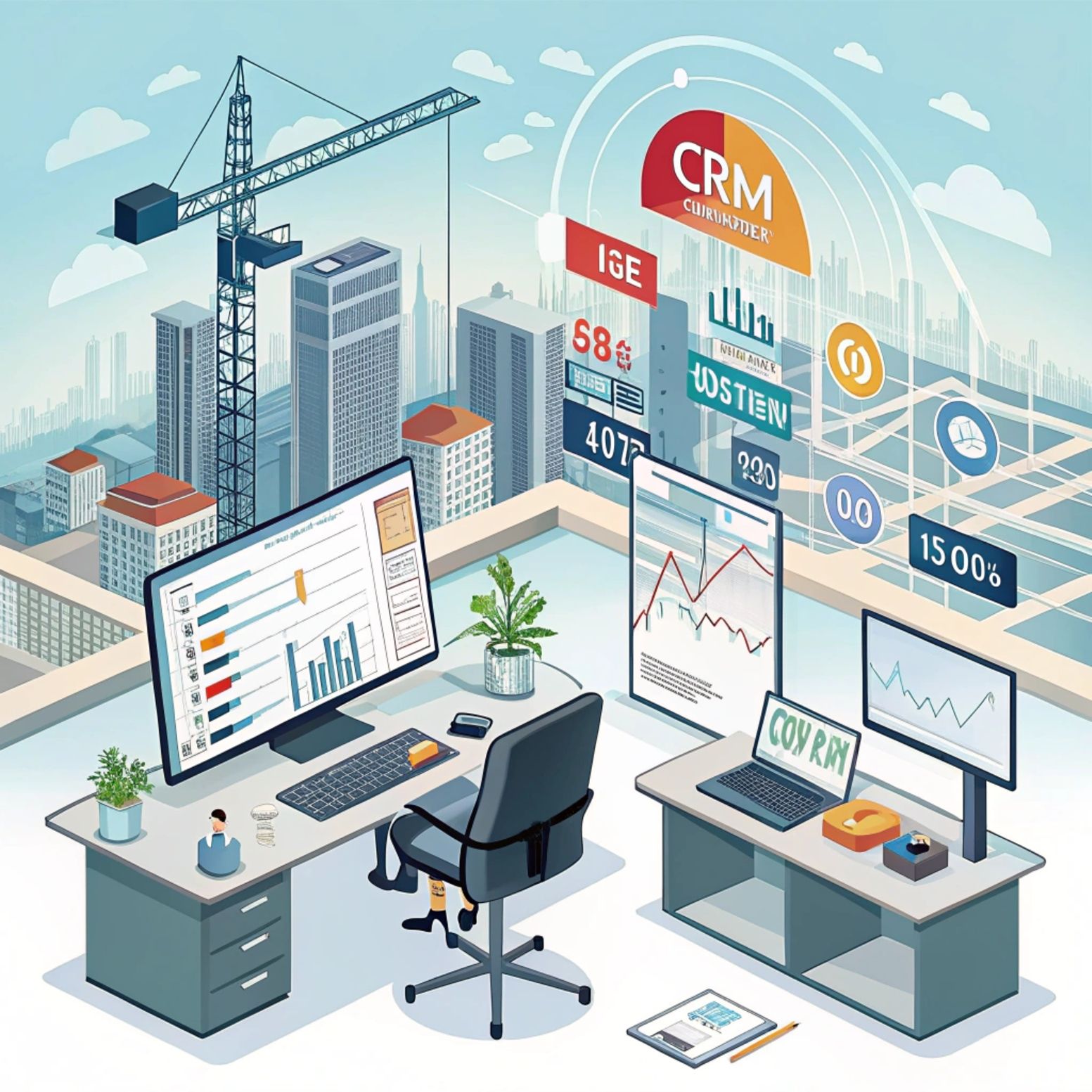
4. Benefits of Custom CRM Development for Real Estate Developers
If you're a real estate developer juggling multiple projects, hundreds of units, and thousands of prospects — you already know the pain of working with rigid software. That’s where custom CRM development changes everything.
A custom-built CRM isn’t just a glorified contact list — it’s a business tool designed specifically around your workflows, your team, and your properties. Let’s explore why more real estate professionals are investing in custom CRM solutions, and how this approach transforms the way they operate.
- Tailored to Your Project Workflow
Real estate isn’t a one-size-fits-all industry. A commercial high-rise in San Francisco isn’t managed the same way as a residential villa development in Florida. A custom CRM is built around your:
- Sales cycles and approval stages
- Construction timelines
- Lead sources and qualification logic
- Investor tracking models
- Local legal and compliance flows
Whether you’re selling off-plan units or coordinating multi-phase builds, the system reflects how your business actually works. No adapting. No compromising.
🛠️ A-Bots.com recently developed a CRM for a Miami-based developer with a built-in unit reservation module and dynamic pricing linked to project phases.
- Powerful Integration with Tools You Actually Use
Your CRM shouldn’t exist in a silo. A custom solution can integrate seamlessly with:
- MLS platforms or proprietary listing databases
- Email clients (Gmail, Outlook)
- Project websites and landing pages
- 1С, QuickBooks, or other accounting software
- WhatsApp Business API or SMS gateways
- E-signature services (DocuSign, Adobe Sign)
- Payment systems (Stripe, PayPal, bank APIs)
Every integration saves time, reduces errors, and increases conversion.
- Advanced Automation That Speeds Up Sales
Tired of manually sending follow-ups, confirming viewings, or updating lead statuses?
Custom CRMs allow for:
- Auto-responses based on source or intent
- Scheduled follow-up sequences
- Status-based task assignment
- Conditional reminders for project milestones
- Smart notifications for team performance
The result: less time on admin, more time closing deals.
- Deep Analytics and Reporting, Built for Real Estate
Custom CRMs let you track what matters:
- Lead conversion by source
- Unit sales velocity per project
- Agent or broker performance
- Payment status breakdowns
- Time-to-close and sales cycle length
You can generate dashboards for investors, board members, or partners — all from a single system. Need a weekly PDF report? Automated. Want real-time KPIs on your phone? Done.
- Multi-Role Access and Secure Collaboration
In a development firm, you’re working with:
- Sales managers
- Marketing teams
- Contractors
- Investors
- Back-office support
With a custom CRM, you define who sees what. Create custom roles, control permissions, and ensure data privacy. Everything is traceable, logged, and secure — no more shared passwords or “oops, I deleted that lead.”
🔐 Custom CRMs built by A-Bots.com can be hosted on private servers, use bank-level encryption, and comply with GDPR, CCPA, or local data protection laws.
- Branding and White-Labeling for Professional Impact
Your CRM is part of your identity. Why should it look like every other company’s backend?
Custom CRMs allow you to:
- Apply your branding, logo, and colors
- Use your domain (e.g. crm.yourcompany.com)
- Customize every screen and label to match your sales language
This isn’t just an aesthetic bonus — it improves user adoption and gives a professional edge in client-facing interactions.
- Built to Grow With You
Whether you have 20 units or 2,000, a custom CRM grows with your business:
- Add new modules when you need them
- Build mobile apps for field sales teams
- Support multiple languages or currencies
- Enable API access for future tools
You’re not locked into a vendor roadmap — you define your own.
At A-Bots.com, we specialize in developing custom CRM systems that do exactly this. Whether you’re a solo developer, a fast-scaling firm, or an established regional player, we help you take control of your sales, data, and growth — with tech that finally fits your business.
Next, let’s explore how the custom CRM development process works — step by step.
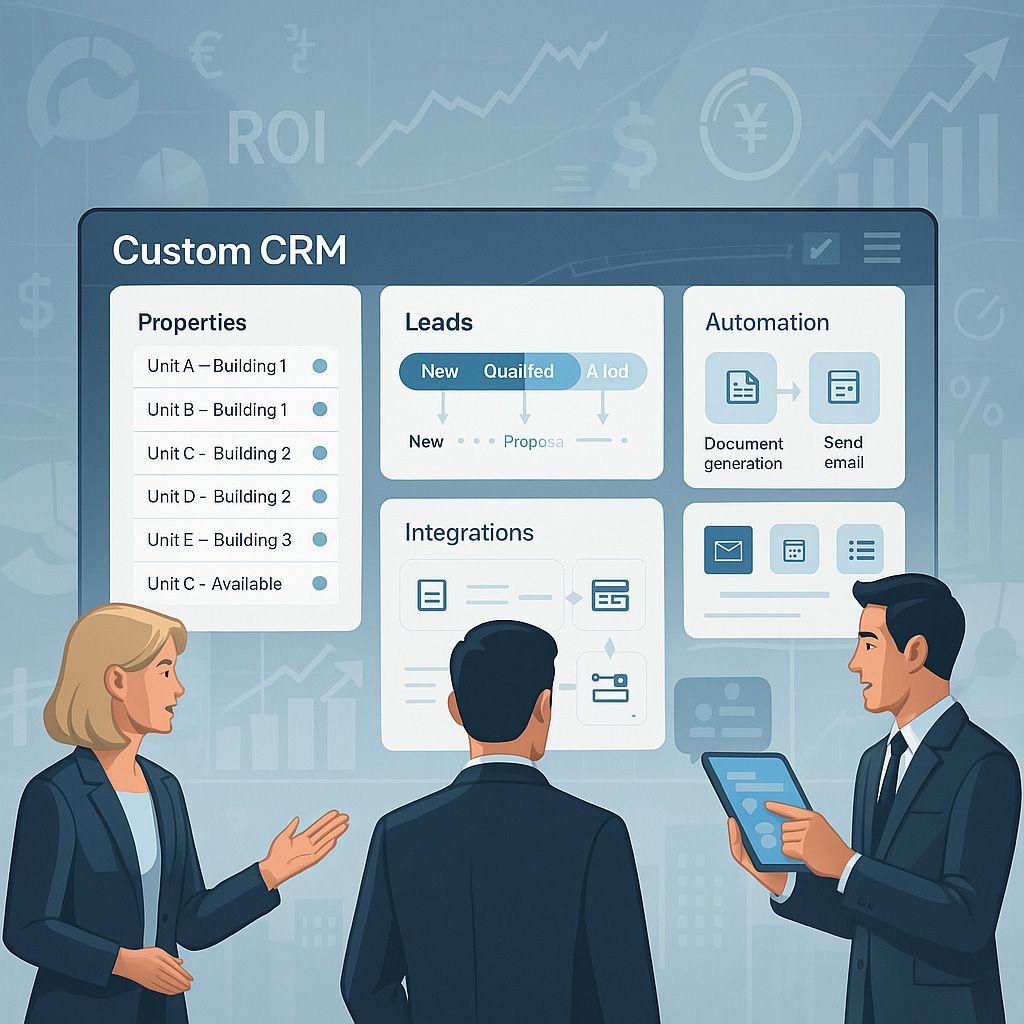
5. How We Build Custom CRM Systems at A-Bots.com
Custom CRM development is often seen as a black box. For many real estate developers, the idea of building a system from scratch sounds intimidating, expensive, and time-consuming. At A-Bots.com, we’ve spent years perfecting a transparent, collaborative process that turns your vision into a powerful working product — without the headaches.
The journey starts long before a single line of code is written. We begin with discovery workshops designed to extract your operational DNA — how leads come in, how they’re tracked, who follows up, how payments are processed, and what data really matters to your team. This phase is about deep understanding, not guesswork. As one of our clients from a mixed-use development firm in Denver put it, “It felt like A-Bots knew our business better than we did after the first call.”
We don’t just gather requirements — we help clarify them. Real estate developers often juggle complex processes across marketing, legal, sales, and finance. Our business analysts work with your leadership team to map out the entire lifecycle of a deal, from lead intake through closing and post-sale follow-up. These insights form the blueprint for the CRM’s architecture.
Next, we move into prototyping. Our designers create interactive wireframes that mirror your future CRM, including navigation, data flows, and user roles. It’s a stage that brings clarity — and saves money — by aligning expectations early. You see exactly what your team will use before a developer even opens their IDE.
Then comes development. Depending on your infrastructure and user base, we choose the most efficient tech stack — whether that’s a web-based portal, mobile-first interface, or hybrid cloud architecture. Our engineers focus on modularity, which means you can launch with core features and expand later without redoing the foundation.
Importantly, we integrate security and compliance from the start. In industries like real estate where deals involve high-net-worth individuals, banking data, and legal documents, privacy and access control are non-negotiable. That’s why every custom CRM we build includes encrypted databases, granular permission settings, and secure audit trails. If your business operates in the EU, California, or any jurisdiction with strict privacy laws, we’ll ensure your solution is GDPR and CCPA compliant from day one.
Testing is ongoing throughout the build. We perform functional, integration, and usability testing across devices and roles. Before go-live, we conduct a full UAT (User Acceptance Testing) phase — not just with your CTO, but also with frontline users like sales reps and project managers. Their feedback ensures your CRM is not only powerful, but also intuitive.
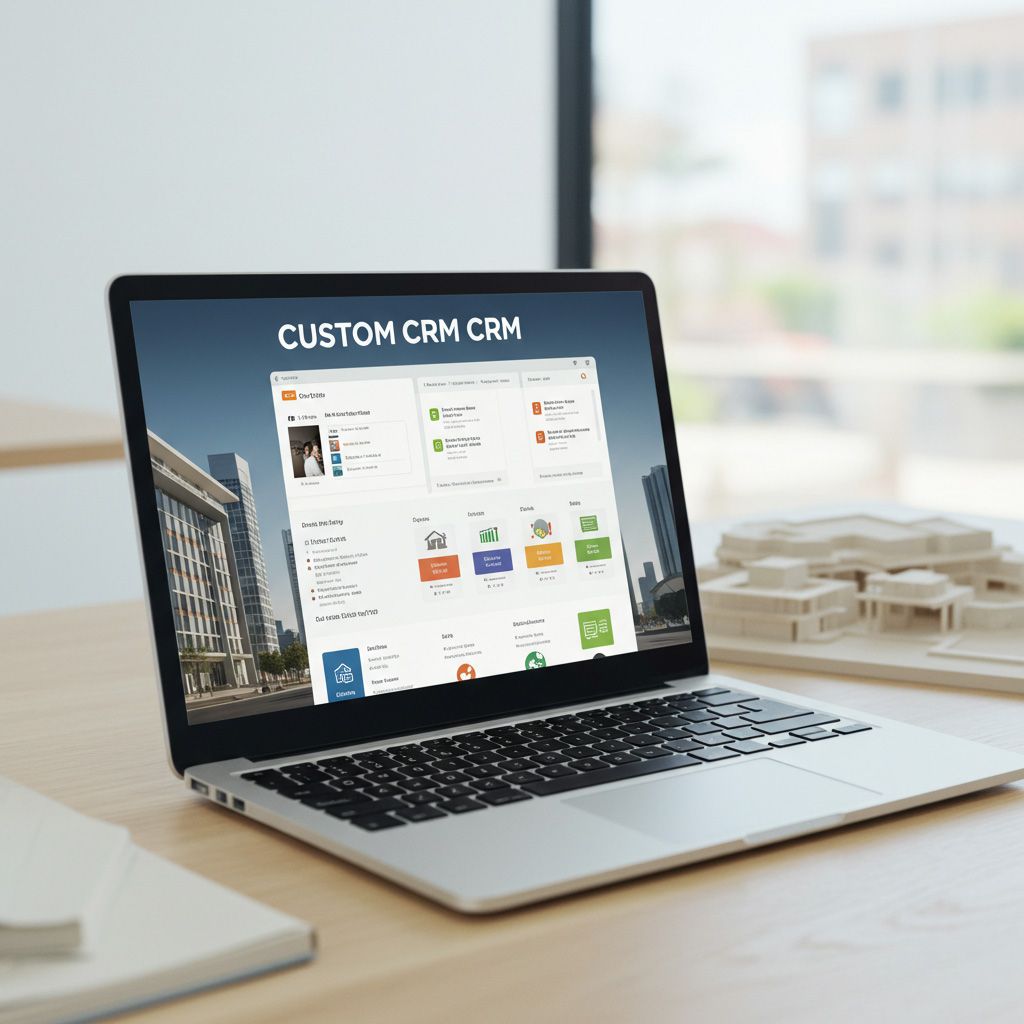
Deployment is never the end. Post-launch, we stay with you. We offer tiered support models — from bug fixes and minor updates to full-scale product evolution as your business grows. Regular feedback loops allow us to refine features and build what matters most. For many clients, our CRMs become living systems that adapt in real time to market conditions and business needs.
Custom development doesn’t have to be complex — when done right, it’s collaborative, strategic, and surprisingly efficient. At A-Bots.com, it’s not just about building software — it’s about building the right software, for the right business, at the right time.
6. Real ROI: Why Custom CRM Pays Off
In the real estate world, return on investment isn’t just a buzzword — it’s the bedrock of every decision. Land, construction, marketing, legal — every cost is evaluated in terms of what it brings back. So it’s only logical that any conversation around custom CRM should be grounded in numbers, not just features.
Let’s start with a fundamental truth: CRM software is not a cost — it’s a multiplier.
It reduces lead loss, shortens sales cycles, improves follow-up rates, automates repetitive tasks, and centralizes decision-making. But how do you measure that impact?
Here’s a simplified formula for CRM ROI:
ROICRM=(((Additional Revenue from CRM)−CRM Cost)/CRM Cost)×100%Now let’s plug in real numbers.
Imagine a mid-sized development firm selling 200 units annually. Before implementing their custom CRM, they had a 12% lead-to-close conversion rate, with ~1,000 leads/year. After launching their CRM — developed by A-Bots.com — their follow-up rate improved by 30%, and their closing rate jumped to 16%. That’s 40 more units sold per year, at an average value of $250,000 per unit.
That’s $10 million in additional revenue.
The cost of CRM development and maintenance over the year was $320,000.
ROICRM=((10,000,000−320,000)/320,000)×100%=3,025%
That’s not a typo — that’s what happens when technology amplifies already strong processes.
Of course, not every project will see four-digit ROI. But even modest improvements in conversion or cycle time can yield massive gains in a high-value industry like real estate. According to research by Nucleus Research, for every dollar spent on CRM, businesses see an average return of $8.71 — and for industries with long sales cycles like real estate, the number is often higher.
Another consideration: subscription creep. Many firms pay $200–$400/month per user for CRM platforms that don’t fully fit their needs. Multiply that by 10–15 staff and 12 months — and you’ve already spent $30,000–$60,000 annually on software you’re only partially using. With a custom CRM, you invest once in something that’s yours — no more vendor lock-in or pricing surprises.
It’s also worth noting the non-monetary ROI. Better client experiences. Faster internal coordination. Real-time reporting. Higher employee satisfaction. Stronger compliance posture. These don’t always show up on balance sheets — but they directly impact reputation, efficiency, and growth.
In short, a custom CRM isn’t an expense — it’s an asset. One that generates value from day one, and continues to pay dividends for years.
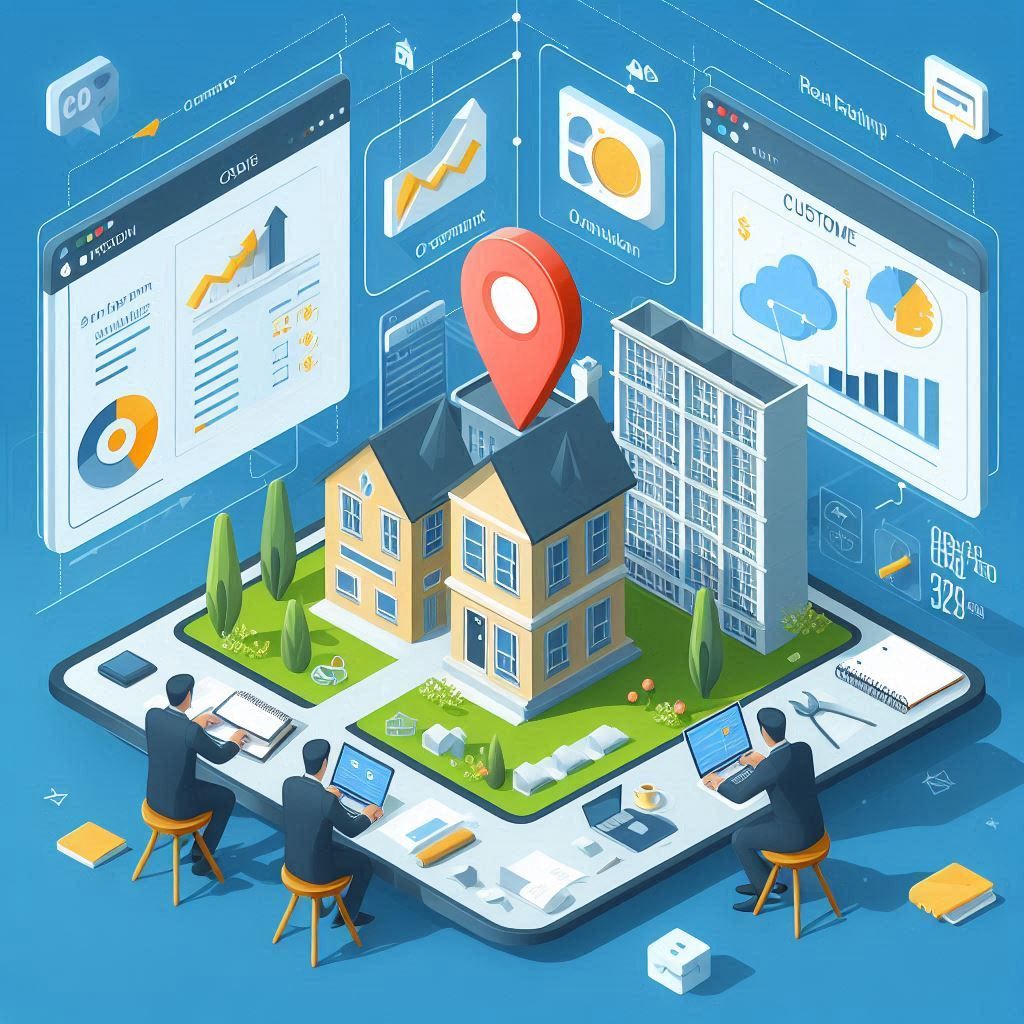
7. The Future Is Custom
There’s a saying in real estate: “You don’t build skyscrapers on shaky foundations.” The same principle applies to your business systems. A developer may have the best architects, salespeople, and capital behind a project — but without the right tools to manage it all, even the most promising venture can underperform.
CRM is more than just software. For modern real estate developers, it has become a strategic platform that underpins every stage of the project lifecycle — from initial investor outreach and lead generation to post-sale support. And as we’ve seen throughout this article, off-the-shelf solutions rarely deliver the precision, adaptability, or control that real estate businesses truly need.
The shift toward custom CRM development isn’t just a tech trend — it’s a natural response to increasingly complex demands. The industry is changing. Projects are larger, timelines tighter, clients more sophisticated, and regulatory oversight more intense. Developers no longer want to “make do” with generic systems that were never designed for their workflows.
They want alignment. Transparency. Agility.
They want technology that reflects their brand, their market, and their ambition.
Let’s be honest — out-of-the-box CRMs are often designed to appeal to the masses. They cater to sales teams, e-commerce shops, SaaS startups. Real estate is an entirely different beast. Its workflows are fluid, its teams multidisciplinary, and its success hinges on timing, relationships, and trust.
A developer managing multiple properties needs to know which units are selling fastest, which brokers are underperforming, which buyers are stalling — in real time. A national sales director wants to launch a targeted campaign to previous investors, segmented by property class and city. An analyst wants to know the ROI by channel, week-over-week, quarter-over-quarter. Try doing that with a CRM built for online t-shirt sales.
Custom CRM systems are not a luxury anymore — they are becoming a competitive requirement.
They give you control over your data, your user experience, your operations. They allow you to integrate seamlessly with third-party tools like MLS platforms, WhatsApp Business API, project management suites, payment gateways, and e-signature solutions. They offer dashboards tailored to your KPIs, not someone else’s. They protect your business with granular access roles and enterprise-grade security. And they grow with you — instead of limiting you.
And here’s another reason why the future is custom: talent retention. Your teams don’t want to struggle with clunky interfaces, broken automations, or tools that require a 40-page manual to understand. With a user-centric CRM that mirrors their daily processes, they work faster, make fewer mistakes, and feel more in control. It’s not just better business — it’s better morale.
At A-Bots.com, we’ve helped real estate clients across different markets — from boutique developers in Miami to commercial firms in Chicago — streamline their operations, reduce manual workload, and unlock growth through smart, scalable CRM systems. We don’t just “develop” software — we build digital infrastructure that supports your long-term vision.
Our process is transparent, flexible, and collaborative. We don’t sell packages. We solve problems. That means sitting with your team to understand the pain points, mapping the customer journey from first click to contract signing, and designing systems that adapt to the way you work — not the other way around.
Whether you’re running a single development or scaling across regions, our mission is simple:
Build you the CRM you would have designed yourself — if you had the time, team, and technical depth.
And you don’t have to start with everything at once. We often begin with a core module — lead management, unit tracking, payment flows — and expand as needed. Think of it like building a custom home: we start with a solid foundation, and layer in the features that matter most to you.
We also believe in long-term partnerships. Our clients come back not because they’re locked into contracts — but because we listen, iterate, and deliver. From post-launch support to version upgrades and training, we’re here to ensure your CRM evolves alongside your business.
Let’s not forget the strategic edge this brings. In today’s market, information is leverage. When you can see every deal, every lead, every metric in real time, you’re not reacting — you’re leading. You’re forecasting trends, identifying opportunities early, and making decisions grounded in data. That’s how modern real estate companies scale. That’s how they dominate.
So if you’re tired of workarounds, frustrated by “good enough” tools, and ready to build a system that finally fits your business like a glove — it’s time to explore custom CRM development.
Let A-Bots.com help you transform your real estate operations into a high-performance engine built on clarity, control, and confidence.
Because in the world of real estate, the only thing more valuable than land — is leverage.
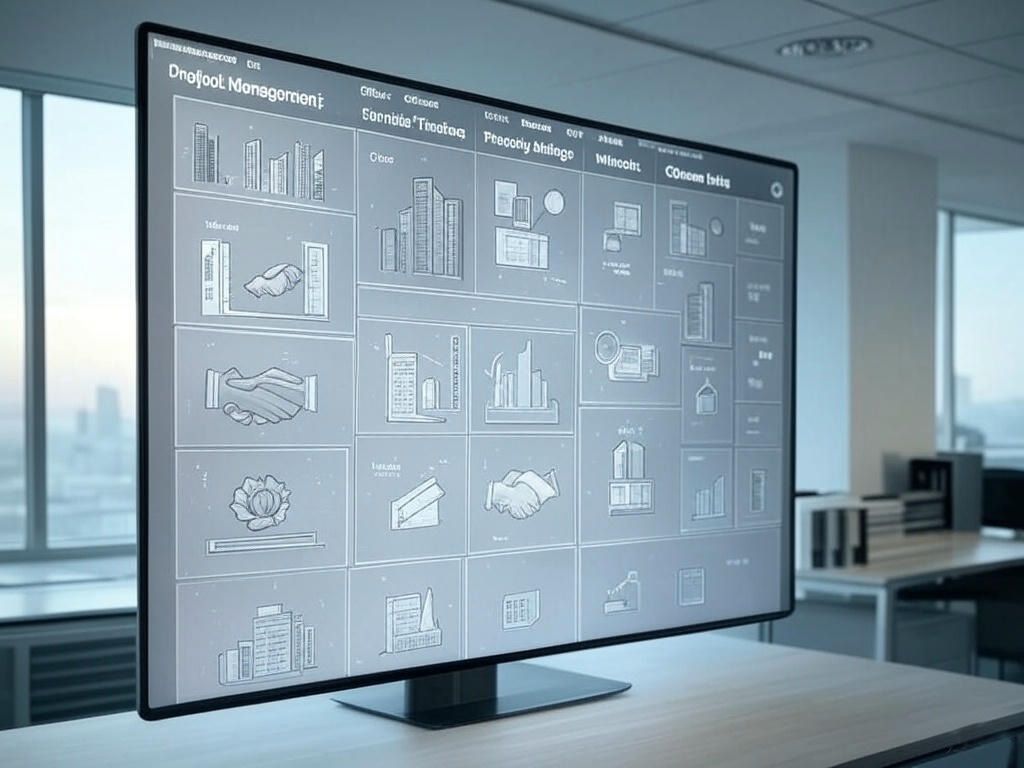
Hashtags
#CustomCRM
#RealEstateCRM
#CRMDevelopment
#RealEstateAutomation
#CRMforDevelopers
#PropertyCRM
#CustomCRMSolutions
#ABots
#CRMDevelopmentCompany
#CustomCRMDevelopment
#CustomSoftware
#CRMsolutions
#PropertyManagementCRM
#RealEstateSaaS
Other articles
Custom Agriculture App Development for Farmers In 2024, U.S. farmers are more connected than ever — with 82% using smartphones and 85% having internet access. This article explores how mobile applications are transforming everyday operations, from drone-guided field scouting to livestock health tracking and predictive equipment maintenance. It examines why off-the-shelf apps often fail to address specific farm needs and how collaborative, farmer-funded app development is gaining momentum. Through real-world examples and step-by-step guidance, readers will learn how communities of growers can fund, design, and launch custom apps that fit their exact workflows. A-Bots.com offers tailored development services that support both solo farmers and agricultural groups. With offline capabilities, modular design, and support for U.S. and international compliance, these apps grow alongside the farm. Whether you're planting soybeans in Iowa, raising cattle in Texas, or running a greenhouse in California — this article offers the tools and inspiration to build your own farm technology. Discover why more farmers are saying: we don’t wait for the future — we build it.
Drone Mapping Software & Control Apps: Custom Solutions for Smart Aerial Operations
Custom drone software is revolutionizing how industries operate—from precision agriculture to infrastructure inspection. This article explores why off-the-shelf apps fall short, how AI and modular design shape the future, and how A-Bots.com delivers tailored drone solutions that truly fit. Whether you manage crops, assets, or entire projects, the right software lifts your mission higher.
Top stories
Copyright © Alpha Systems LTD All rights reserved.
Made with ❤️ by A-BOTS
